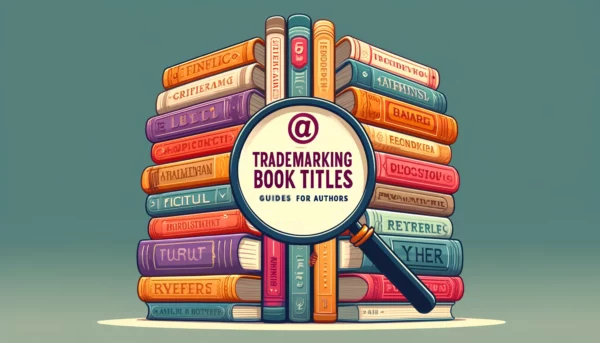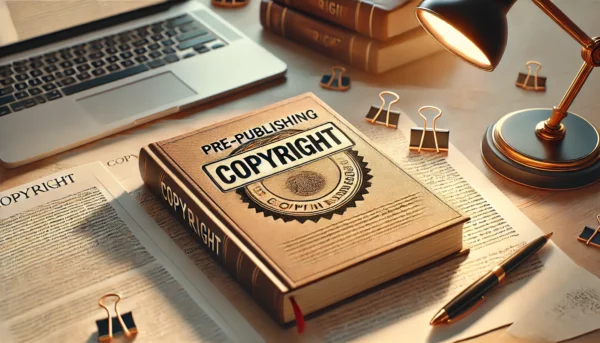So, you’ve written a book. Hours of typing, coffee spills, and last-minute rewrites have brought you to the finish line. Congratulations! Now, there’s just one thing left to consider—your book copyright notice. That small yet mighty copyright statement for books isn’t just a legal technicality—it’s your way of saying, “Hey, this belongs to me, hands off!” A standard copyright notice for books helps protect your rights, making it clear that your book copyright text is off-limits without permission. Whether it’s a copyright disclaimer for books or full copyright information for a given book, this simple step secures your hard work.
In this article, we’ll go over what a copyright notice is, why it matters (especially for self-published authors), and how you can create one that’s both professional and protective.
What Is a Copyright Notice?
A copyright notice is a simple yet powerful declaration that you own the rights to your book. It usually includes three elements: the copyright symbol (©), the year of publication, and your name (or your pen name, if you prefer). Think of it as your book’s ID badge – it tells the world, “This is my creation, and I hold the rights to it.”
While it might seem like a small addition, a copyright notice serves a few essential purposes. First, it informs readers and potential copycats that your work is protected, giving them a nudge to think twice before using or copying it without your permission. Second, it can strengthen your position in a legal context if you ever need to enforce your rights. For self-published authors, it’s a straightforward way to claim your creative territory without jumping through too many hoops.
In short, a copyright notice may be small, but it packs a big punch in protecting your hard work.
Why You Need a Copyright Notice
Including a copyright notice in your book isn’t just for show; it provides several important benefits that protect you as an author. Here’s why it matters:
- Establishes Ownership: Adding a copyright notice is a clear way of stating, “This book belongs to me.” It formally claims your ownership over your work, making it easier to prove your rights if needed.
- Acts as a Deterrent: A copyright notice is like a “No Trespassing” sign for your book. While it may not stop every unauthorized use, it does warn people that your work is protected, encouraging them to think twice before copying it.
- Strengthens Legal Protection: Should you ever face a case of infringement, a copyright notice is helpful in court. Although not legally required to enforce your rights, it can strengthen your position by showing you took steps to safeguard your work.
In short, a copyright notice isn’t just a formality; it’s an easy way to secure your rights and deter unauthorized use.
Do All Books Need a Copyright Notice?
The short answer? Technically, no. In the United States, your book is automatically protected by copyright law as soon as it’s in a fixed form (like written on paper or saved on a computer). However, adding a copyright notice offers extra benefits that are especially valuable to self-published authors and indie publishers.
A copyright notice is a proactive move that strengthens your claim over the work, making it clear that your book is protected. While traditionally published books usually come with all the copyright bells and whistles provided by the publishing company, self-published authors handle this aspect independently. For those venturing into self-publishing, a copyright notice is a simple, low-cost way to add an extra layer of copyright protection too.
If you’re wondering about exceptions, they exist. Books in the public domain or works with expired copyrights (think classics from the 1800s) don’t need a copyright notice. But for most modern authors, including a copyright notice is a wise step in protecting your creative efforts, whether it’s in print, digital format, or both.
Step-by-Step: How to Write Your Copyright Notice
Creating a copyright notice is straightforward, and adding it to your book takes only a few minutes. Here’s a quick guide to help you craft a clear and professional copyright notice:
1. The Copyright Symbol (©)
Begin with the © symbol to indicate that the work is copyrighted. If you can’t type it, simply write “Copyright.”
2. Year of Publication
Next, include the year your book is first published. This marks the date you officially claim your rights over the content. For example: “© 2024.”
3. Your Name or Pen Name
Add your name to make it clear who owns the copyright. Self-published authors typically use their own name or pen name, while traditionally published books might list the publishing company. For example: “© 2024 by Jane Doe.”
4. Rights Reserved Statement (Optional)
To strengthen protection, you can add “All rights reserved.” This phrase signals that no part of the book may be used without permission.
Example of a Complete Copyright Notice:
“© 2024 by Jane Doe. All rights reserved.”
Adding these elements creates a polished copyright notice that protects your book from unauthorized use.
Where Should the Copyright Notice Go?
Now that you’ve crafted your copyright notice, the next step is placing it in the right spot within your book. The book copyright notice typically goes on the copyright page, a dedicated page usually located right after the title page. This page is where readers (and anyone curious about rights and permissions) can easily find information about the book’s copyright status.
Some authors choose to place the copyright notice directly on the title page if they prefer a minimalist format. However, having a separate copyright page is standard and provides space for additional details, like disclaimers, edition information, and the ISBN.
Why does placement matter? Placing the copyright notice on the copyright page or title page ensures it’s visible and officially documented within the book. This simple step can help you avoid confusion and will keep your rights clearly documented in an accessible location.
Additional Information to Include on the Copyright Page
Beyond the basic copyright notice, your copyright page also is a great place to add other important details that protect your book and make it look polished. Here are some common elements to consider:
Library of Congress Control Number (LCCN): If you’ve applied for an LCCN, include it here. This cataloging number is especially useful for books distributed in libraries and helps libraries easily identify your work.
ISBN: The International Standard Book Number (ISBN) is a unique identifier for your book, especially essential for print editions. Including the ISBN on your copyright page makes it easy for bookstores, libraries, and online retailers to catalog your book.
Edition Information: If your book has multiple editions or printings, note the edition here (e.g., “First Edition”). This is helpful for readers and collectors and is particularly relevant if your book undergoes updates.
Disclaimers: Disclaimers protect you legally by clarifying that your book is fictional, or that any resemblance to actual persons or real people is coincidental, if applicable.
All Rights Reserved Notice: While optional, “All rights reserved” reinforces that your work is fully protected and may not be used without prior written permission.
Example:
“Library of Congress Control Number: 2024001234
ISBN: 978-3-16-148410-0
First Edition”
Adding these details makes your copyright page look professional and provides extra layers of clarity and protection for your work.
Understanding Copyright Law and Your Rights as an Author
Copyright law can feel a bit daunting, but it’s an essential part of protecting your rights as an author. Essentially, copyright law grants you, the creator, exclusive rights to your book, covering everything from reproduction to distribution. Once your book exists in a tangible form—like a digital file or a printed copy—it’s automatically protected under U.S. copyright law. This means no one can legally copy, distribute, or adapt your work without your permission.
For authors, especially self-publishers, understanding these rights is important. While adding a copyright notice is a great start, registering your copyright with the U.S. Copyright Office offers even stronger protection. Registration provides a public record of your ownership and gives you the ability to take legal action if someone uses your work without permission.
Key Rights Protected by Copyright Law:
- Reproduction Rights – Only you can make copies of your book.
- Distribution Rights – You control where and how your book is sold.
- Adaptation Rights – Any adaptations (like film rights) require your consent.
Understanding these protections can help you make informed decisions about your work and ensure it stays uniquely yours.
Permission Requests: What to Do if Others Want to Use Your Content
When your book is published, readers and other creators may want to quote sections, share parts of your work, or even adapt it for their own projects. This is where permission requests come in. Permission requests are formal inquiries from individuals or organizations seeking your approval to use specific portions of your book.
Here’s how to handle them:
When to Grant Permission: If someone requests to use a short excerpt for a book review or a brief quotation in an article, you might grant permission without much concern. For larger uses, such as including entire chapters or adapting your work into a different medium, you may want to charge a fee or limit how it’s used.
Formalizing Permissions: Always get permission agreements in writing. A simple, written permission statement clarifies what is allowed and avoids misunderstandings.
Setting Boundaries: You don’t have to grant every request. As the copyright owner, you can decide what’s best for your book and your brand. Consider setting up a permissions coordinator or creating a form on your author website to handle these requests easily.
By handling permission requests professionally, you can maintain control over your content while potentially opening new opportunities for exposure.
What to Include If You Self-Publish vs. Using a Publishing Company
The approach to copyright and permissions varies depending on whether you’re self-publishing or working with a traditional publishing company. Here’s a breakdown of what to consider in each scenario:
Self-Publishing
As a self-publisher, you hold all the rights to your book, giving you complete control over the copyright notice, permissions, and any legal disclaimers. You’ll be responsible for creating the copyright page, adding the ISBN, securing the Library of Congress Control Number (if needed), and managing the permissions notice and permission requests. Self-publishing allows you to customize the copyright page, so don’t hesitate to include disclaimers or additional statements, like “All rights reserved,” to mark your ownership.
Publishing Company
If you publish through a traditional or hybrid publishing company, they typically handle the copyright and legal details. The publisher usually places their name on the copyright page as part of their company’s services, and they might also hold some rights to the book, such as distribution or adaptation rights, depending on your contract. However, the author’s name is still usually credited as the primary copyright holder.
Note for Self-Publishers: Retaining control over the copyright page and notice is a unique advantage of self-publishing, as it allows you to fully define and protect your work. For those using a publishing company, review your contract carefully to understand what rights you retain and what the publisher manages.
Legal Disclaimers and Rights Reserved Statements
Including a legal disclaimer on your copyright page adds an extra layer of protection for both you and your readers. A disclaimer clarifies that the book is a work of fiction (if applicable) and that any resemblance to real people or events is coincidental. This helps shield you from potential claims by individuals who might feel they recognize themselves in your characters or story.
Another common addition is the “All Rights Reserved” statement. This phrase asserts that you, as the author, retain all rights to your book, meaning no part can be reproduced, distributed, or used in any form without your permission.
Examples of Common Legal Disclaimers:
- Fiction Disclaimer: “This is a work of fiction. Names, characters, businesses, places, and incidents are either the products of the author’s imagination or used in a fictitious manner.”
- All Rights Reserved Statement: “All rights reserved. No part of this book may be reproduced, stored in a retrieval system, or transmitted in any form or by any means without the author’s written permission.”
Adding these statements to your copyright page is a simple but effective way to protect your rights and minimize the risk of legal issues down the line.
Tips for Drafting Your Copyright Page
Your copyright page is more than just a formality; it’s a key part of your book’s professionalism and protection. Here are a few tips to make sure yours is polished and effective:
Use a Template for Consistency
If you’re new to formatting, consider using a copyright page template. Many resources online provide free templates specifically for self-publishers, helping you maintain a professional layout and avoid errors.
Keep It Simple and Clear
While it’s tempting to add extra information, the copyright page works best when it’s straightforward. Stick to essentials like the copyright notice, ISBN, edition details, and any necessary disclaimers.
Add a “First Edition” or Print Run Note
For authors expecting multiple editions, adding “First Edition” or the date of printing can help readers identify which version they have, a feature valued by collectors and libraries alike.
Include Contact Information (If Applicable)
If you’re open to permission requests or inquiries, consider adding your email address or a link to your author website. This allows interested parties to reach out without hunting for your information.
These simple tips can elevate the professionalism of your book’s copyright page and make it easier for readers, collectors, and potential partners to understand your work’s protected status.
Final Thoughts on Including a Copyright Notice
Including a copyright notice in your book might seem like a small step, but it’s a powerful one. Not only does it establish your ownership over your work, but it also discourages unauthorized use and adds a layer of professionalism to your book. Whether you’re self-publishing or working with a publishing company, a well-constructed copyright page helps ensure your rights are clear and protected.
If you’re self-publishing, here’s a tip that can make the process even easier: Spines offers a free copyright certificate when you upload your manuscript. This certificate provides an extra layer of protection and formalizes your rights as the author, helping you easily secure your creative investment. It’s a quick, affordable way to let the world know that your work is uniquely yours.
Ready to protect your book? Upload your manuscript on Spines today and get your free copyright certificate!
Your Publishing Journey Awaits – Start NowFAQs
Q1: What is a copyright notice in a book?
A copyright notice is a statement that asserts ownership of a book and informs readers that it is legally protected. It typically includes the copyright symbol (©), the publication year, and the author’s name. Though not legally required, it strengthens your claim to your work and acts as a deterrent against unauthorized use.
Q2: Do I need a copyright notice in my book?
While your book is automatically copyrighted upon creation, including a copyright notice provides clear documentation of ownership and reinforces legal protection in case of infringement. It’s especially beneficial for self-published authors who handle their own copyright details.
Q3: How do I write a copyright notice for my book?
A standard copyright notice includes:
- The copyright symbol (©)
- Year of publication
- Author’s name or pen name
- Optional: “All rights reserved” for added protection
Example: © 2024 by Jane Doe. All rights reserved.
Q4: Where should I place the copyright notice in my book?
The copyright notice is usually found on the copyright page, located immediately after the title page. This page may also include additional information like the ISBN, edition details, disclaimers, and permissions statements.
Q5: What happens if I don’t include a copyright notice?
Your book is still protected under copyright law, but not having a notice may weaken your ability to prove ownership in disputes. A copyright notice clearly signals that your work is protected and discourages unauthorized use.
Q6: How much does it cost to copyright a book?
Copyright protection is free upon creation, but registering with the U.S. Copyright Office provides stronger legal protection. The registration fee typically ranges from $45 to $125, depending on the filing method and type of work.
Q7: What additional information should I include on my copyright page?
Aside from the copyright notice, consider including:
- Library of Congress Control Number (LCCN) – Useful for library cataloging
- ISBN – Identifies your book for retailers and libraries
- Disclaimers – Clarifies legal protections (e.g., “This is a work of fiction.”)
- Permissions and contact info – Provides details on rights and usage requests
Q8: Does self-publishing affect copyright ownership?
No, self-publishing does not affect your copyright ownership—you retain full rights to your book. However, traditional publishing contracts may assign some rights (e.g., distribution or adaptation). Always review your publishing agreement to ensure you understand your rights.







